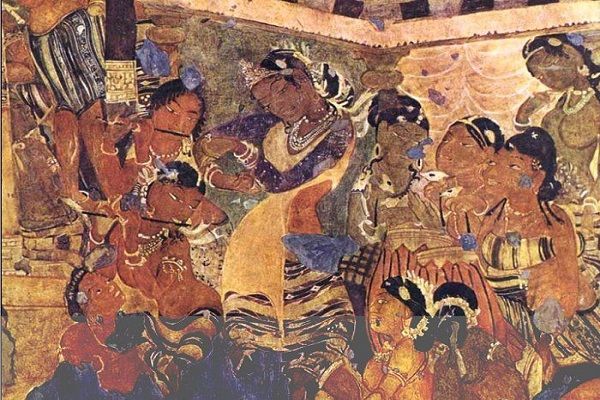
There were caves and rocks for Indian paintings before there were canvases and brushes.
The modern types of Indian art that you see today actually evolved from prehistoric cave drawings. Learn more about the magnificence of these ancient forerunners and how they continue to inspire contemporary artists.
Before you start learning about the history, have a look at oil painting gallery- IndianArtIdeas.in.
When and why did early man start painting? What made him see colours in his head? Was it just his wish to paint the landscapes he had seen, or was there more to it? We now understand how he had used his cave walls as his canvas and every earthly thing conceivable as his tools, even though we will never fully understand why and how the craft began.
How Could India, a Mythical Land, Avoid the Trend?
Fine Indian artists who have utilised the rock media have grown throughout prehistory. The murals in the Ajanta and Ellora caves, where they still survive today, provide the clearest examples. The artwork found in the Sittanavasal monastery and the Bagh caves provide as more proof.
Of course, the country's geography and the variety of its civilizations were two important aspects that had supported the development of the arts there. Although such creations are frequently thought to have a brief lifespan, it's noteworthy to note that the Indian Oil paintings have been astonishingly conserved over time.
From Prehistory to Ancient and Medieval Times, the art had then descended.
Thousands of tiny caves and rock shelters with prehistoric artwork still visible on their walls can be found if you explore every nook and cranny of the nation. Some of these works of art date back 30,000 years or perhaps longer. You will see that the tendency had extended throughout the country at that time, from the formidable Himalayas to the Tamil Nadu coastline. The sites where the early man's craft inspired individuals to continue the tradition in its most pure form are mentioned below.
The Keralan Ezhuthola Paintings:
The Ezhuthola cave paintings, though now nearly destroyed, are among the most exquisite works of ancient art. The cave, which is in Kerala's Marayur-Chinnar forest zone, is home to twenty-one incredible red ochre paintings. The Ezhuthola paintings mostly talk about life during the prehistoric era, with humans and animals being the main subjects, even if they continue to elude experts' curiosity.
Chattisgarh's Beautiful Jogimara Cave Art:
Some of the most magnificent artwork from the first century BC can be found in the cave. The designs are blatant allusions to the first-ever, deliberate attempt to spruce up a land's grounds. Images that have been developed in two layers can be found on the walls and ceilings. Red, black, yellow, and white colours are frequently used, as well as line drawings. In reality, these drawings frequently have a red outline. All throughout the place are painted human figures, fish, elephants, flowers, birds, and chariots. They don't mention religion, though.
The Ajanta Frescoes:
These ancient Mahayana Buddhist structures are found in the Maharashtra region's Aurangabad area. They largely concentrate on the life and teachings of Gautam Buddha, as you will see if you pay great attention to them. It is popular to depict figures from myths. There would therefore be many goddesses, Nagas, Yakshas, Vrikshikas, and other beings that were essential to the supernatural essence of that time. The oldest Indian oil paintings on display are in Cave 10, which dates back to the first century BC.
The works are original. They are frescoes painted with earth tones on mud plaster. They may be found virtually everywhere, including on ceilings and walls, and they describe the court life of the time, including feasts and celebrations for both men and women, of festivals, and of flora and animals as well. The most significant feature of these paintings is that shading techniques were used by the artists of that era to create a three-dimensional look, which is a significant progress in the art.
The mural paintings in Ellora's Kailasa Temple:
Only the paintings at the Kailasa temple were able to be effectively conserved, despite the fact that they were present in five of the Ellora caves. The mural paintings at Ellora were created over the course of two series, which is what makes them so unique. The first round occurred when the caves were being carved, and the final round took place millennia later.
Sharp, robust forms and pointy noses are very subtly depicted in the drawings. These works in the Ellora caves were the first to exhibit prominent, projecting eyes, a hallmark facial feature of the people of Gujarat. This is a significant indicator of the inter-regional influences that dominated at the time. The latter series extensively depicts Shaivism, indicating that years later, religious influence was strong.
The Frescoes of Sittanavasal:
In Tamil Nadu's Pudukottai district lies the Sittanavasal caves. It is thought that there is a connection between these wall carvings, which are remarkably similar to those in Ajanta, and the Thanjavur Chola depictions. They also demonstrate the Pandyan period's profound influence. Animals, birds, lotuses, and dancing human figures are the most prevalent subjects.
White, a made from lime colour, has been used to compose the drawings for the most part. In addition to these hues, there is also black made from wood charcoal, red made from red ochre, yellow made from yellow ochre, blue made from lapis lazuli stones, and olive green made from terre verte (earth green).
The paintings from Kanker Cave:
These drawings were just just unearthed, but it's thought that they date back 10,000 years, suggesting that they originate from the prehistoric period. The artworks, which were painted using earth-based colours, are astoundingly still in tact after all these years.
The bizarre sculptures show human-like beings holding what appear to be weapons. Strangely, these figurines don't have a mouth or a nose. Because some of the drawings show the creatures wearing costumes that resemble space suits, scientists are convinced that the representation is of aliens. If all of these assertions are correct, this will be a ground-breaking discovery that will shed light on how prehistoric humans interacted with extraterrestrial life.





















